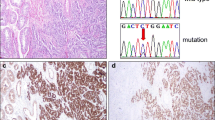Abstract
In 20 sex-cord tumors of the testes, we investigated immunohistochemistry as a possible method for histopathological diagnosis and evaluation of prognosis. We examined the following molecules: inhibin, CD99, cytokeratin, vimentin, MIB-1, estrogen receptors and progesterone receptors. These tumors of the testes comprised 18 Sertoli cell tumors (ScT) and two undifferentiated sex-cord tumors (USCT). Four tumors have been considered as malignant, because of metastatic spread. Inhibin was expressed by the tumor cells in 80% of sex cord tumors, without any correlation to the degree of differentiation and only in 25% of the malignant cases. Inhibin is a specific marker for sex-cord tumors of the testis and is particularly useful for the diagnosis of USCT. CD99, vimentin, keratin, progesterone and estrogen receptors were expressed in, respectively, 60%, 75%, 35%, 65% and 20% of cases; 95% expressed one of the three following markers: inhibin, CD99 or vimentin. Proliferation index MIB-1 was equal to or higher than 30% in the four malignant cases versus less than 20% in other cases. Lack of inhibin expression and a proliferation index (MIB-1) greater than 30% should be considered as a criterion in favor of malignancy.



Similar content being viewed by others
References
Amin MB, Young RH, Scully RE (1998) Immunohistochemical profile of Sertoli cell tumors of the testis. Mod Pathol 11:76A
Arora DS, Cooke IE, Ganesan TS, Ramsdale J, Manek S, Charnock FM, Groome NP, Wells M (1997) Immunohistochemical expression of inhibin/activin subunits in epithelial and granulosa cell tumors of the ovary. J Pathol 181:413–418
Compérat E, Tissier F, Vieillefond A (2004) Métastase ganglionnaire 10 ans après orchidectomie. Ann Pathol 24 (in press)
Düe W, Dieckmann, K-P, Niedobitek G, Bornhoft G, Loy V, Stein H (1990) Testicular sex cord stromal tumor granulosa cell differentiation: detection of steroid hormone receptors as a possible basis for tumor development and therapeutic management. J Clin Pathol 43:732–737
Gordon MD, Corless C, Renshaw AA, Beckstead J (1998) CD99, keratin, and vimentin staining of sex cord-stromal tumors, normal ovary and testis. Mod Pathol 11:769–773
Henley JD, Young RH, Ulbright TM (2002) Malignant Sertoli cell tumors of the testis. A study of 13 examples of a neoplasm frequently misinterpreted as seminoma. Am J Surg Pathol 26:541–550
Iczkowski KA, Bostwick DG, Roche PC, Cheville JC (1998) Inhibin A is a sensitive and specific marker for testicular sex cord-stromal tumors. Mod Pathol 11:774–779
Kinniburgh D, Anderson RA (2001) Differential patterns of inhibin secretion in response to gonadotrophin stimulation in normal men. Int J Androl 24:95–101
Kommoss F, Oliva E, Bittinger F, Kirkpatrick CJ, Amin MB, Bhan AK, Young RH, Scully RE (2000) Inhibin-alpha, CD99, HEA 125, PLAP, and chromogranin immunoreactivity in testicular neoplasms and the androgen insensitivity syndrome. Hum Pathol 31:1055–1061
Kratzer SS, Ulbright TM, Talerman A, Srigley JR, Roth LM, Whale G, Moussa M, Stephens JK, Millos A, Young RH (1997) Large cell calcifying Sertoli cell tumor of the testis. Contrasting features of six malignant and six benign tumors and a review of the literature. Am J Surg Pathol 21:1271–1280
Matias-Guiu X, Pons C, Prat J (1998) Mullerian inhibiting substance, alpha-inhibin, and CD99 expression in sex cord-stromal tumors and endometroid ovarian carcinomas ressembling sex cord-stromal tumors. Hum Pathol 29:840–845
McCluggage WG, Shanks JH, Whiteside C, Maxwell P, Banerjee SS, Biggart JD (1998) Immunohistochemical study of testicular sex cord-stromal tumors, including staining with anti-inhibin antibody. Am Surg Pathol 22:615–619
Mostofi FK, Price EB Jr (1973) Tumors of the male genital system. In: Firminger HI (ed) Atlas of Tumor Pathology. Fascicle 8, Series 2. Armed Forces Institute of Pathology, Washington, DC, pp 85–114
Nachtigall LB, Boepple PA, Seminara SB, Khoury RH, Sluss PM, Lecain AE, Crowley WF Jr (1996) Inhibin B secretion in males with gonadotropin-releasing hormone (GnRH) deficiency before and during long-term GnRH replacement: relationship to spontaneous puberty, testicular volume, and prior treatment—a clinical research center study. J Clin Endocrinol Metab 81:3520–3525
Ulbright TM, Srigley JR, Reuter VE, Wojno K, Roth LM, Young RH (2000) Sex cord stromal tumors of the testis with entrapped germ cells. A lesion mimicking unclassified mixed germ cell sex cord stromal tumors. Am J Surg Pathol 24:535–542
Young RH, Koelliker DD, Scully RE (1998) Sertoli cell tumors of the testis, not otherwise specified. A clinicopathologic analysis of 60 cases. Am J Surg Pathol 22:709–721
Author information
Authors and Affiliations
Corresponding author
Rights and permissions
About this article
Cite this article
Compérat, E., Tissier, F., Boyé, K. et al. Non-Leydig sex-cord tumors of the testis. The place of immunohistochemistry in diagnosis and prognosis. A study of twenty cases. Virchows Arch 444, 567–571 (2004). https://doi.org/10.1007/s00428-004-1017-1
Received:
Accepted:
Published:
Issue Date:
DOI: https://doi.org/10.1007/s00428-004-1017-1




